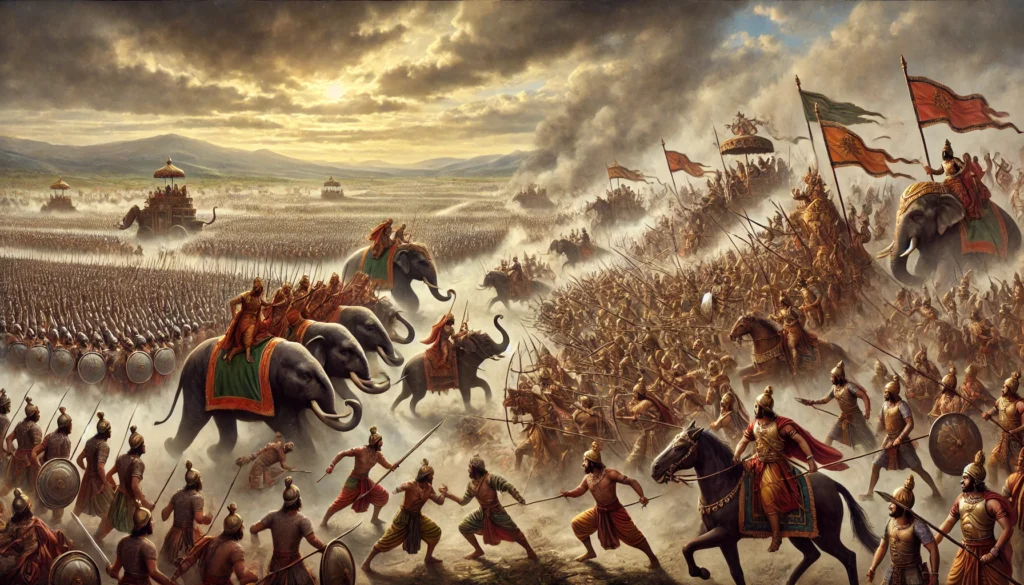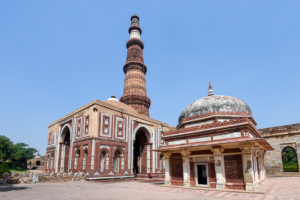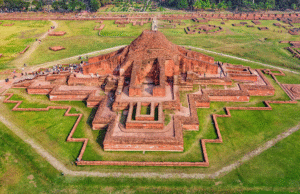
Ancient Indian Wars (3500 BCE–200 CE) – Introduction:
The early history of the Indian subcontinent is marked by a series of monumental wars and conflicts that shaped its political, social, and cultural evolution. From the legendary Kurukshetra War, as detailed in the Mahabharata, to the real-life conquests of Chandragupta Maurya and Ashoka’s transformative Kalinga War, these early battles laid the foundation for empires and shaped regional boundaries. This article explores the most significant wars in ancient India from the Vedic era to the rise of the Mauryan Empire, focusing on their impact on early Indian civilization.
1. Battle of Ten Kings (Dasharajna)
- Belligerents: King Sudas of the Bharata Tribe vs. a confederation of ten kings (tribes like Puru, Yadu, Druhyu, Turvasa, and Anu).
- Location: Banks of the River Ravi, Punjab region (modern-day Pakistan).
- Year: Circa 1500 BCE.
- Outcome: Victory for King Sudas and the Bharata Tribe.
- Aftermath: This established the Bharata tribe’s dominance in the region, setting the stage for the rise of the Kuru Kingdom.
2. Kurukshetra War (Mahabharata)
- Belligerents: Pandavas vs. Kauravas.
- Location: Kurukshetra, Haryana.
- Year: Estimated around 1000 BCE (though the exact date is debated).
- Outcome: Victory for the Pandavas.
- Aftermath: The Pandavas regained their kingdom, but the war caused massive loss of life and disrupted many regional powers in northern India.
3. Conquest of Magadha by Bimbisara
- Belligerents: Bimbisara (Magadha) vs. neighboring tribes and kingdoms.
- Location: Magadha (modern-day Bihar).
- Year: Circa 543 BCE.
- Outcome: Expansion of Magadha’s territory.
- Aftermath: Bimbisara’s successful campaigns laid the foundation for the Magadha Empire, which would later rise to prominence under the Maurya dynasty.
4. Vatsa-Magadha War
- Belligerents: Vatsa Kingdom vs. Magadha under Ajatashatru.
- Location: Northern India (modern-day Uttar Pradesh and Bihar).
- Year: Circa 5th century BCE.
- Outcome: Victory for Magadha.
- Aftermath: Ajatashatru’s conquest of Vatsa marked the expansion of Magadha’s power, which soon became the most dominant kingdom in northern India.
5. Invasion of Alexander the Great
- Belligerents: Alexander the Great (Macedonian Empire) vs. King Porus (Paurava Kingdom).
- Location: Hydaspes River, modern-day Jhelum River, Pakistan.
- Year: 326 BCE.
- Outcome: Tactical victory for Alexander, but Porus retained his kingdom.
- Aftermath: This marked the first major contact between the Greek and Indian worlds, leading to exchanges in culture, art, and trade. Alexander’s campaign in India ended soon after as his army refused to march further.
6. Nanda-Maurya War
- Belligerents: Chandragupta Maurya (Maurya Empire) vs. Dhana Nanda (Nanda Empire).
- Location: Magadha (modern-day Bihar).
- Year: Circa 322 BCE.
- Outcome: Chandragupta Maurya overthrew Dhana Nanda and founded the Maurya Empire.
- Aftermath: This victory marked the beginning of the Mauryan Empire, which became one of the most powerful and influential empires in ancient Indian history.
7. Conquest of Kalinga by Ashoka
- Belligerents: Maurya Empire under Ashoka vs. Kalinga.
- Location: Kalinga (modern-day Odisha).
- Year: 261 BCE.
- Outcome: Victory for the Maurya Empire, but at great human cost.
- Aftermath: The immense bloodshed led Ashoka to embrace Buddhism and renounce violence, spreading the principles of non-violence and moral governance across his empire and beyond.
8. Battle of Pataliputra (185 BCE)
- Belligerents: Pushyamitra Sunga vs. the Maurya Empire (last Mauryan king Brihadratha).
- Location: Pataliputra (modern-day Patna, Bihar).
- Year: 185 BCE.
- Outcome: Victory for Pushyamitra Sunga.
- Aftermath: This battle marked the fall of the Maurya Empire and the establishment of the Sunga dynasty, which would go on to rule significant parts of northern India.
9. Kharavela’s Campaigns
- Belligerents: Kharavela (King of Kalinga) vs. various regional rulers, including the Satavahanas.
- Location: Southern India and Central India.
- Year: Circa 2nd century BCE.
- Outcome: Kharavela expanded his kingdom.
- Aftermath: Kharavela’s conquests strengthened Kalinga’s influence in southern India, and he became a significant patron of Jainism, as evidenced by the Hathigumpha inscription.
10. Satavahana-Kshatrapa Wars
- Belligerents: Satavahana Empire vs. Western Kshatrapas.
- Location: Western and Central India.
- Year: 1st century BCE to 2nd century CE.
- Outcome: Ongoing conflicts with both sides gaining and losing territories over time.
- Aftermath: These wars shaped the political boundaries of western India. The Satavahanas and Kshatrapas influenced the cultural and commercial exchanges in the region, particularly along trade routes.
11. Bharata-Puru War
- Belligerents: Bharata tribe vs. Puru tribe.
- Location: Sapta Sindhu (Punjab region).
- Year: Circa 1500 BCE.
- Outcome: Victory for the Bharata tribe.
- Aftermath: Established the Bharata tribe as a dominant power, which eventually contributed to the rise of the Kuru Kingdom.
12. Magadha-Vajji War
- Belligerents: Magadha under King Ajatashatru vs. Vajji Confederacy (Lichchhavis).
- Location: Vaishali (modern-day Bihar).
- Year: Circa 484 BCE.
- Outcome: Victory for Magadha.
- Aftermath: The annexation of Vajji allowed Magadha to expand its territory, contributing to the rise of the Magadha Empire.
13. Battle of Ujjayini (Shishunaga-Magadha War)
- Belligerents: Shishunaga (Magadha) vs. Kingdom of Avanti.
- Location: Ujjayini (modern-day Ujjain, Madhya Pradesh).
- Year: Circa 5th century BCE.
- Outcome: Victory for Magadha.
- Aftermath: The defeat of Avanti further weakened the kingdom, allowing Magadha to expand its influence over central India.
14. Magadha-Kosala War
- Belligerents: King Prasenjit of Kosala vs. King Ajatashatru of Magadha.
- Location: Kosala (territories around modern-day Uttar Pradesh).
- Year: Circa 5th century BCE.
- Outcome: Victory for Magadha.
- Aftermath: Kosala became a subordinate ally of Magadha, enhancing Magadha’s dominance in northern India.
15. Sunga-Yavana Conflict
- Belligerents: Sunga Empire vs. Indo-Greek (Yavana) invaders.
- Location: Northern India (regions around Mathura and Pataliputra).
- Year: Circa 180 BCE.
- Outcome: Sunga Empire defended its territories, with the Indo-Greeks failing to gain a significant foothold.
- Aftermath: The Yavana (Indo-Greek) presence in the northwest continued to affect trade and cultural exchanges, but they could not conquer the heartland of the Sunga Empire.
16. Indo-Greek Wars
- Belligerents: Indo-Greek Kingdoms vs. Indian dynasties (such as the Shungas and Satavahanas).
- Location: Gandhara and Punjab (modern-day Afghanistan and Pakistan).
- Year: 2nd century BCE to 1st century BCE.
- Outcome: Ongoing skirmishes with fluctuating control over territories.
- Aftermath: Indo-Greeks established multiple small kingdoms in northwestern India but were eventually overrun by other invading tribes, including the Shakas and Kushans.
17. Kushan Invasions
- Belligerents: Kushan Empire vs. Indo-Greek Kingdoms and local Indian rulers.
- Location: Bactria and Gandhara (modern-day Afghanistan, Pakistan, and northern India).
- Year: Circa 1st century CE.
- Outcome: The Kushan Empire successfully took control of large territories in the north.
- Aftermath: The Kushans established dominance in the northern Indian subcontinent and contributed to cultural and trade exchanges along the Silk Road.
18. Satavahana-Kalinga War
- Belligerents: Satavahana Empire vs. Kingdom of Kalinga.
- Location: Kalinga (modern-day Odisha and parts of Andhra Pradesh).
- Year: Circa 1st century CE.
- Outcome: The war led to a stalemate, with no clear victor.
- Aftermath: Kalinga retained its autonomy, while the Satavahana Empire maintained control over the Deccan region.
19. Cheras-Cholas Conflict
- Belligerents: Chera Kingdom vs. Chola Kingdom.
- Location: Ancient Tamilakam (modern-day Tamil Nadu and Kerala).
- Year: Circa 2nd century BCE to 2nd century CE.
- Outcome: Prolonged conflict with no decisive winner, though both kingdoms had periods of dominance.
- Aftermath: These conflicts contributed to shaping the political boundaries of southern India, with both kingdoms influencing trade across the Indian Ocean.
20. Scythian Invasions (Shaka Wars)
- Belligerents: Scythians (Shakas) vs. Indian dynasties like the Satavahanas and Indo-Greeks.
- Location: Saurashtra and western India (modern-day Gujarat and Maharashtra).
- Year: 1st century BCE to 1st century CE.
- Outcome: The Shakas established the Western Kshatrapas in western India.
- Aftermath: The Scythian (Shaka) rulers exerted influence over parts of western and northwestern India for several centuries, contributing to the regional political dynamics.
21. Battle of Vidarbha
- Belligerents: Satavahana Empire vs. local rulers of Vidarbha.
- Location: Vidarbha (modern-day Maharashtra).
- Year: Circa 1st century CE.
- Outcome: Victory for the Satavahana Empire.
- Aftermath: The battle helped the Satavahanas consolidate their control over central India and establish greater influence in the Deccan region.
22. First Tamil-Sri Lankan War
- Belligerents: Chola Kingdom vs. Kingdom of Anuradhapura (Sri Lanka).
- Location: Tamilakam and Anuradhapura (modern-day Tamil Nadu and Sri Lanka).
- Year: Circa 2nd century BCE.
- Outcome: The Cholas raided Anuradhapura.
- Aftermath: The war led to Tamil influence in Sri Lankan politics and trade, with occasional Chola intervention in the island’s affairs.
23. Battle of Rajagriha (Magadha-Avanti War)
- Belligerents: Magadha Empire vs. Avanti Kingdom.
- Location: Rajagriha (modern-day Rajgir, Bihar).
- Year: Circa 4th century BCE.
- Outcome: Victory for Magadha under King Bimbisara.
- Aftermath: The defeat of Avanti helped Magadha consolidate its power in northern India, laying the groundwork for future expansions under the Mauryan Empire.
24. Battle of Sagala (Indo-Parthian Conflicts)
- Belligerents: Indo-Parthians vs. Indo-Greeks and local Indian rulers.
- Location: Sagala (modern-day Sialkot, Pakistan).
- Year: Circa 1st century BCE.
- Outcome: Victory for Indo-Parthians.
- Aftermath: The Indo-Parthians established their rule in parts of northwestern India, affecting the region’s political landscape until the Kushan Empire rose to prominence.






